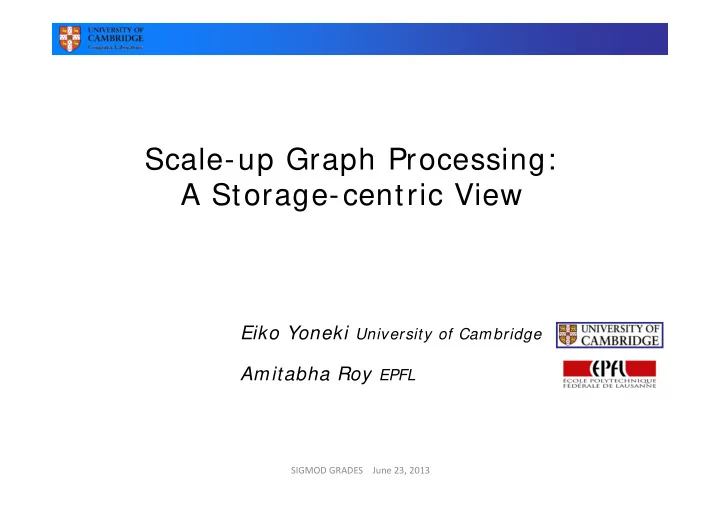

Scale-up Graph Processing: A Storage-centric View Eiko Yoneki University of Cambridge Amitabha Roy EPFL SIGMOD GRADES June 23, 2013
Graph Storage � Storing and accessing graphs is a challenge � Edge traversal produces an access pattern that is � Random � Unpredictable 1 2 3 4 5 6 � For scale up or limited scale out (small clusters) � Storage bottlenecks (RAM, SSD, Magnetic disk) in critical path 2 SIGMOD GRADES June 23, 2013
RASP and X-Stream � Storage-centric: two different novel ways to access graph structured data � Batch processing of large graphs on single machine � Establish useful limits for single machine processing � Directly address storage bottlenecks RASP: Accelerates random access using a novel prefetcher X-Stream: Sequentially streaming a large set of (potentially unrelated) edges � RASP and X-stream take (diametrically opposite) storage centric view of graph processing problems 3 SIGMOD GRADES June 23, 2013
RASP: Run Ahead SSD Prefetcher � Prefetching allows cheap hardware to compete with supercomputing for suitable graph traversal � Prefetcher ensures that edge data to progress computation is always available in memory � Allows graph traversal to keep queue depth high � SSD to achieve good performance � Vertices (O(V)) size structure in memory � Edges in SSD in CSR format � Efficient on traversal: WCC, BFS, SSSP, A* … 4 SIGMOD GRADES June 23, 2013
Edge Queue Management � Prefetcher invokes any registered callbacks, accessing the current state of the main program’s iterator � Asynchronous page load requests to OS via fadvise � Repeat to ensure future data to active LRU list Adjacency list and edge weights in CSR 5 SIGMOD GRADES June 23, 2013
RASP Speedup � Speedups from up to 13x comparing over single and multithreaded versions � RASP Memory usage WCC � RASP Runtime (mins) for WCC 6 SIGMOD GRADES June 23, 2013
Vertex/ Edge Centric Access � Vertex centric access is random � Edge centric access is more sequential � Can subdivide into streaming partitions Vertices Vertices Random Edges Random Sequential Edges Sequential 7 SIGMOD GRADES June 23, 2013
X-Stream: Streaming Partitions � Sequential access to any medium � Eliminate random access to edges � Ensure randomly accessed vertices held in cache Random Sequential Vertices Edges On-disk graphs In-memory graphs Random Vertices Sequential Edges 8 SIGMOD GRADES June 23, 2013
Scale-up with X-stream � Scaling up through RAM, SSD and Magnetic Disk 2B vertices/32B edges/23 hours 128M vertices/2B edges/26 mins 8M vertices/256M edges/23 sec Lower is better (run with 16 cores machines) 9 SIGMOD GRADES June 23, 2013
Pros and Cons � RASP clearly provides impressive speedup � Improving inefficiency of random access to SSD by prefetching � Limitation � RASP requires pre-processing to CSR format � RASP is specific to SSD � Focus is traversal based graph computation (not for DFS) � X-Stream transforms them to sequential access � Single building block of streaming partitions � Works well with RAM, SSD, and Magnetic Disk � Limitation � X-stream needs to trade off fewer random accesses to edge list for sequential bandwidth of streaming a large number of potentially unrelated edges 10 SIGMOD GRADES June 23, 2013
RASP+ X-Stream Hybrid Approach � Allow streaming partitions to sort their associated edges and access them randomly � Starting point is X-stream style streaming � Low utilization of edges due to few active vertices triggers index building � Switch to RASP style prefetching after index is available � Streaming partition has the necessary vertex subset in memory: a requirement for RASP � RASP mitigates limitations of X-Stream � Wasted edges due to inactive vertices � Particular problem for high diameter graphs 11 SIGMOD GRADES June 23, 2013
IVEC Programming Model � Abstract interface for graph algorithms, we intend to support � Iterative Vertex-Centric programming model � Scatter: Vertex state � updates along edges � Gather: Updates on incoming edges � vertex state � IVEC can be mapped to Pregel, Powergraph, Graphchi ... � GreenMarl (optimised iterative operation) � Can express variety of graph operations � BFS/ WCC, SSSP, PageRank, MIS… � But not algorithms with O(E) state, such as triangle counting � Hides complexity of algorithms and storage from each other 12 SIGMOD GRADES June 23, 2013
Conclusion � Storing and accessing graphs is a challenge since it is determinant for performance in graph processing � RASP and X-stream: address diametrically opposite storage centric view of graph processing problem RASP: Accelerates random access with prefetcher X-Stream: Sequentially streaming edges � Towards hybrid approach of RASP + X-Stream � Scale out for bandwidth and capacity � Target 1T edges � Explore 'limited' scale out � Network does not become the bottleneck � Multiply storage capacity, bandwidth and compute � Tightly coupled solutions: micro servers, low power boards 13 SIGMOD GRADES June 23, 2013
Recommend
More recommend